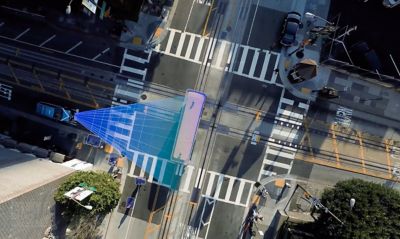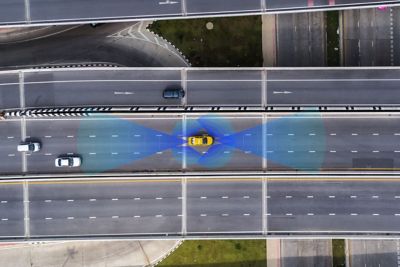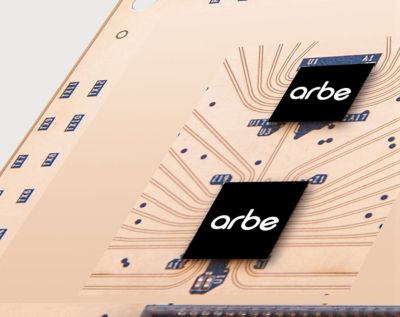-
United States -
United Kingdom -
India -
France -
Deutschland -
Italia -
日本 -
대한민국 -
中国 -
台灣
-
-
產品系列
查看所有產品Ansys致力於為當今的學生打下成功的基礎,通過向學生提供免費的模擬工程軟體。
-
ANSYS BLOG
December 22, 2022
Arbe Sets its Sights on Safer Autonomous Driving with Ansys
Of all the roadblocks to achieving true road safety and eventually realizing fully autonomous driving, perception is arguably the biggest. Self-driving vehicles have trouble distinguishing objects outside of their direct line of sight, including cyclists and pedestrians. That’s because current non-line-of-site (NLOS) object identification methods associated with available perception technology depend on indirect reflections, or faint signals emanating from these objects. Because these signals are so faint, they are often misread or overlooked by advanced driver-assistance system (ADAS) and autonomous vehicle (AV) systems, impeding a vehicle’s ability to anticipate any movements that can lead to a collision.
To achieve full autonomy, self-driving systems must be able to see and respond as a human driver would. The big concern here is safety, and the overriding question is: Can self-driving vehicles act as a human driver, with the same level of perception to avoid pedestrians and obstacles?
With the support of Ansys simulation software, Arbe may have found the answer. The company develops radar chipset solutions that incorporate the Doppler effect into a phased array radar defined by an increase or decrease in wave frequency dictated by movement of a source toward or away from an object. The result is a high-resolution radar solution that helps autonomous vehicles (AVs) to avoid what’s ahead, facilitating their safer operation in the real world.

Arbe radar solutions enable autonomous vehicles and advanced driver assistance systems to “see” and foresee various driving scenarios ahead.
According to Arbe, it was a goal enabled by Ansys simulation with a focus not just on the chip and hardware side, but on full perception performance in the environment as it relates to the vehicle surroundings using front, back, and surround radar.
Great Beginnings Yield Big Discoveries
Of course, a lot has changed for Ansys Startup Program alum Arbe since 2020, when the automotive supplier began using Ansys simulation software, followed by the launch of its surround imaging radar.
“The starter bundle that Ansys provided was quite a game changer at the time, because we got all the tools, solvers, and supports we needed,” says Asaf Even Chen, VP Radar Chipset at Arbe. “And it has really enabled us to have a more mature product, to model and do some pretty complex analysis of our package, including RX chips, printed circuit boards, antenna and radome, and all the environment simulation that goes along with it. And by using Ansys tools we are able to improve system performance and also reduce our development time.”
All of this analysis resulted in Lynx Surround imaging radar, a solution that outperforms current industry radars in a small form factor with low power consumption at an affordable price. The radar, combined with Arbe’s Phoenix Perception radar, has been identified as an industry first in its ability to deliver 360-degree imaging and perception around a vehicle, which won the CES 2023 Innovation Award.

Similar to the radar systems used to catch speeding cars, Arbe’s long-range front radar and surround radars bounce radio waves off stationary and moving objects. The system then couples them with perception algorithms and artificial intelligence (AI) to understand how the radio waves reflect off secondary objects they encounter. This enables it to distinguish separate objects of various sizes ahead, detect people walking between vehicles, identify road users in all weather and lighting conditions, separate signals from small and large objects, and more.
Seeing Solutions Everywhere with Simulation
Creating a system at this level of complexity presented several engineering challenges for the Arbe development team. Operating in a very high frequency range, all the radio frequency (RF) system components involved were extremely small in size and densely packed together, resulting in multiple interference and signal integrity issues. A tool capable of accurate simulation and analysis was needed to design and build these components with a clear understanding of the interactions among them as part of a larger system.
To do this, Arbe’s development team used Ansys HFSS, a 3D electromagnetic simulation software running on Ansys Cloud Direct with the capability to design and simulate all the high-frequency products involved in their radar solution, such as integrated circuits, antennas, and printed circuit boards (PCBs).
“The entire system is quite complicated, so we need a really smart and powerful tool for the right level of analysis,” says Assaf Stav, RF and Antenna Engineer. “Analysis involves going through the layers of the PCB, the radiation elements, and the mechanics of the whole radar. Using all kinds of Ansys tools and solvers running in the cloud, we can get a highly accurate model that gives us a deeper understanding of the complexity of these components and the interactions between them.”
Simulation Helps Arbe Score Big with Unique System-on-Chip Designs

Arbe’s radar chipset solution holds the highest channel count with the highest processing power.
Another big win for Arbe is a recent 340,000 radar chipset preliminary order. It’s a big milestone that requires fulfilling numerous automotive regulations for safety and quality using simulation as a reliable guidepost. For 2023, the focus in this area will be to shift into mass production of Arbe’s chipset and progressing the automotive industry into the next phase of cutting-edge safety.
Using HFSS helps Arbe analyze the simulated model of all of their new chipset package designs to come up with viable products. Based on their success with HFSS, the development team is also expanding their use of the software on several new PCB designs.
Staying Ahead of the Curve with HFSS
Working through chipset design challenges was a flash point for Arbe’s development team, to such an extent that it provided them with a reference design they could look to when developing different PCBs, antenna types, or system mechanics for customers. Ultimately, lessons learned using Ansys software enabled the team to reduce customer manufacturing times by several months and pass on significant savings to their customers.
“We can easily import files from other tools and programs we are using in order to perform a variety of tests using simulation, and then based on the results, make modifications and changes to our products,” says Assaf Stav, RF and Antenna Engineer. “This activity also applies to radiating elements, including antenna where we are testing different concepts like waveguides, or in support of customer design analysis, all done within Ansys tools.”
All this activity is a big win for customers, who can build a sample first and send it in to Arbe for analysis. Using HFSS, the development team can do all of the measurements, then iterate using an existing reference design as a guide. By using simulation, the team can also guarantee most of the performance very early on in the design process and set its sights on bigger projects in the future.
Interested in learning more about Ansys’ role in helping Arbe deliver a radar solution that is overcoming perception challenges to help deliver autonomous driving experiences? Be sure to visit Ansys’ booth #4401 at the CES in January.










